MITSUBISHI COLT 2008 Owner's Manual (in English)
Manufacturer: MITSUBISHI, Model Year: 2008, Model line: COLT, Model: MITSUBISHI COLT 2008Pages: 450, PDF Size: 14.57 MB
Page 301 of 450
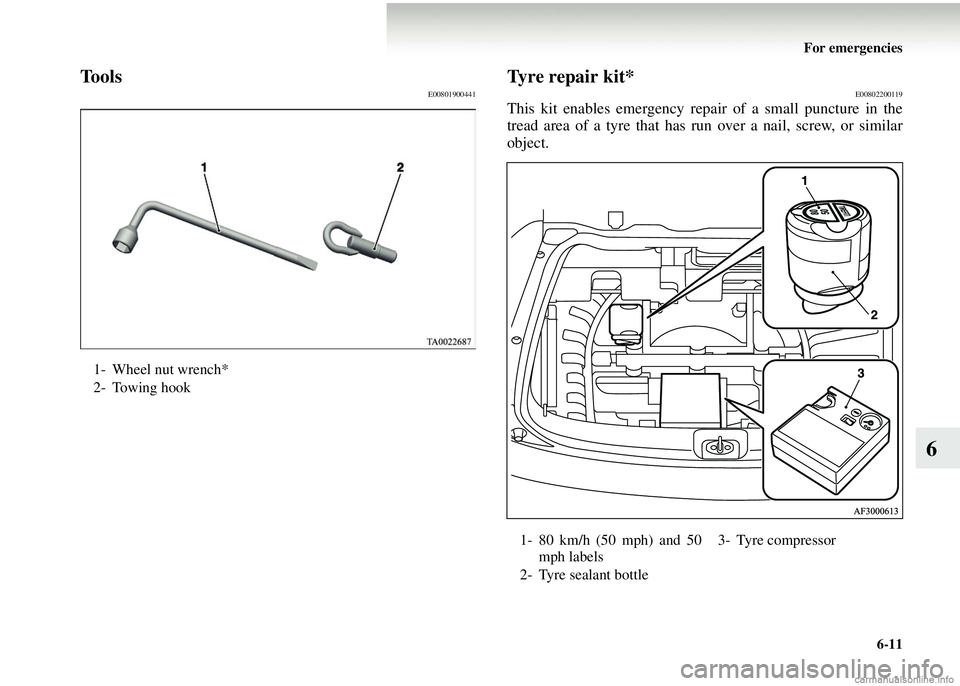
For emergencies6-11
6
ToolsE00801900441Tyre repair kit*E00802200119
This kit enables emergency repair of a small puncture in the
tread area of a tyre that has run over a nail, screw, or similar
object.
1- Wheel nut wrench*
2- Towing hook
1- 80 km/h (50 mph) and 50mph labels 3- Tyre compressor
2- Tyre sealant bottle
Page 302 of 450
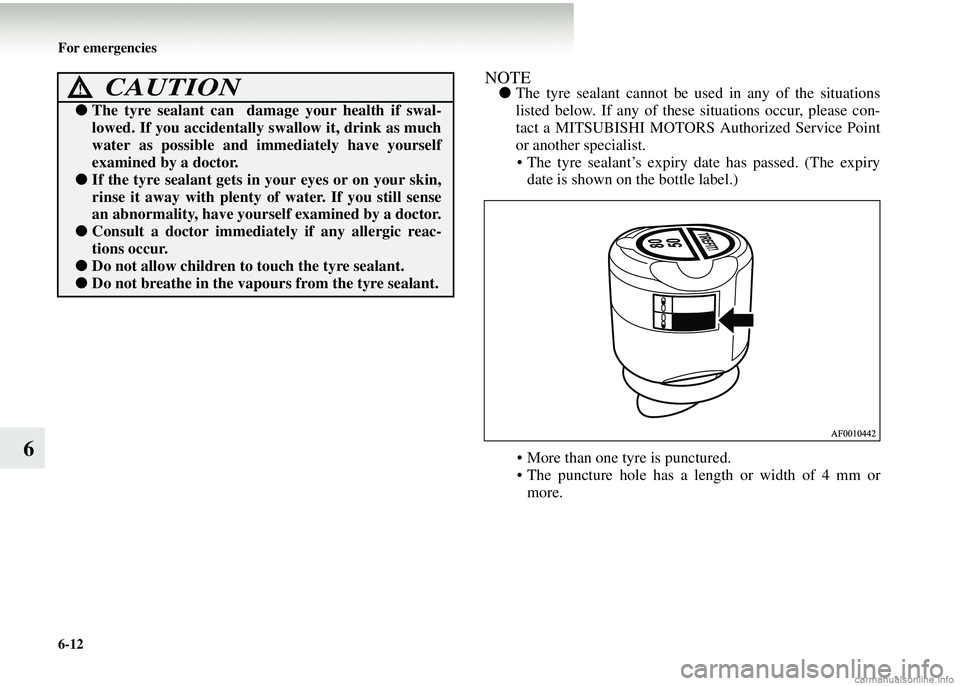
6-12 For emergencies
6
NOTE●The tyre sealant cannot be used in any of the situations
listed below. If any of these situations occur, please con-
tact a MITSUBISHI MOTORS Authorized Service Point
or another specialist.
• The tyre sealant’s expiry date has passed. (The expiry date is shown on the bottle label.)
• More than one tyre is punctured.
• The puncture hole has a length or width of 4 mm or more.CAUTION!
● The tyre sealant can dam age your health if swal-
lowed. If you accidentally swallow it, drink as much
water as possible and immediately have yourself
examined by a doctor.
● If the tyre sealant gets in your eyes or on your skin,
rinse it away with plenty of water. If you still sense
an abnormality, have yourse lf examined by a doctor.
●Consult a doctor immediately if any allergic reac-
tions occur.
●Do not allow children to touch the tyre sealant.
●Do not breathe in the vapo urs from the tyre sealant.
Page 303 of 450
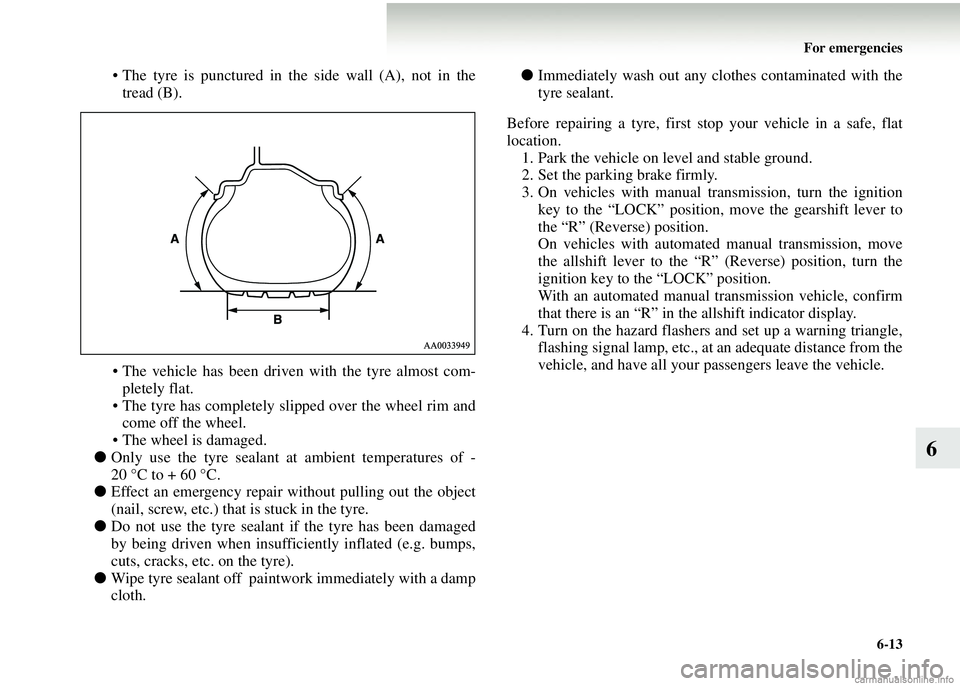
For emergencies6-13
6
• The tyre is punctured in the side wall (A), not in thetread (B).
• The vehicle has been driven with the tyre almost com-
pletely flat.
• The tyre has completely sl ipped over the wheel rim and
come off the wheel.
• The wheel is damaged.
● Only use the tyre sealant at ambient temperatures of -
20 °C to + 60 °C.
● Effect an emergency repair without pulling out the object
(nail, screw, etc.) that is stuck in the tyre.
● Do not use the tyre sealant if the tyre has been damaged
by being driven when insufficiently inflated (e.g. bumps,
cuts, cracks, etc. on the tyre).
● Wipe tyre sealant off paintwork immediately with a damp
cloth. ●
Immediately wash out any clot hes contaminated with the
tyre sealant.
Before repairing a tyre, first stop your vehicle in a safe, flat
location. 1. Park the vehicle on level and stable ground.
2. Set the parking brake firmly.
3. On vehicles with manual transmission, turn the ignition key to the “LOCK” position, move the gearshift lever to
the “R” (Reverse) position.
On vehicles with automated manual transmission, move
the allshift lever to the “R” (Reverse) position, turn the
ignition key to the “LOCK” position.
With an automated manual transmission vehicle, confirm
that there is an “R” in th e allshift indicator display.
4. Turn on the hazard flashers and set up a warning triangle, flashing signal lamp, etc., at an adequate distance from the
vehicle, and have all your passengers leave the vehicle.
Page 304 of 450

6-14 For emergencies
6
5. If the vehicle is on a gradient, place a chock or block (A)at the tyre that is diagonally opposite the tyre (B) you are
repairing.
NOTE● The chock shown in the illustration does not come with
your vehicle. It is recommended that you keep one in the
vehicle for use if needed.
● If a chock is not available, use a stone or any other object
that is large enough to hold the wheel in position. 6. Take out the tyre sealant bottle and the compressor.
NOTE●
In cold conditions (when the ambient temperature is 0 °C
or lower). Warm the bottle inside the vehicle.
7. Shake the tyre sealant bottle (C) well.
Page 305 of 450
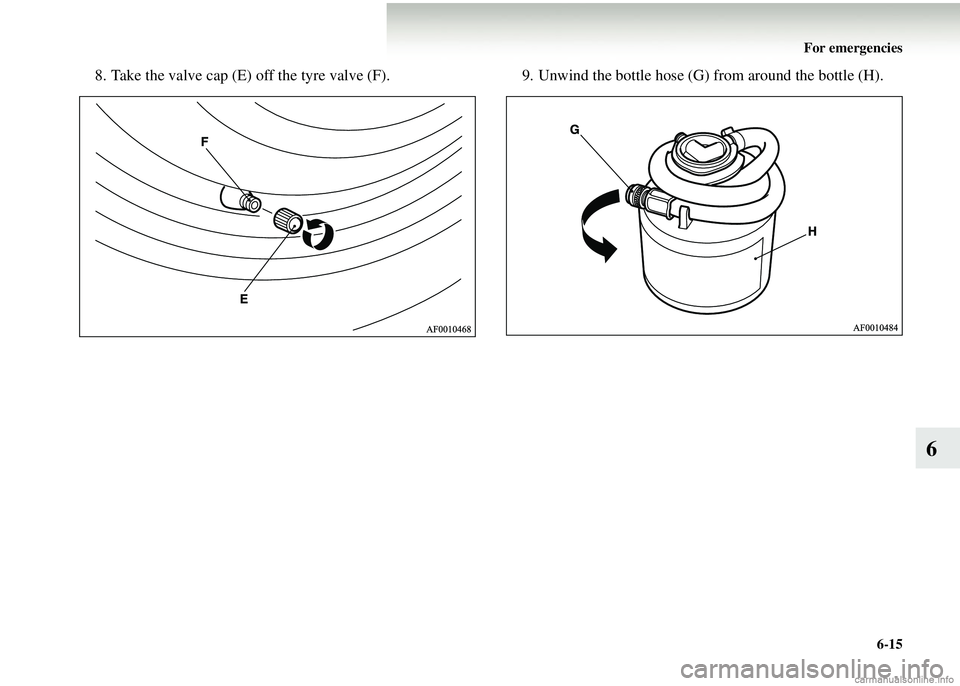
For emergencies6-15
6
8. Take the valve cap (E) off the tyre valve (F). 9. Unwind the bottle hose (G) from around the bottle (H).
Page 306 of 450

6-16 For emergencies
6
10. Pull out the compressor’s hose (H) from the bottom of thecompressor and securely attach it to the valve (I) of the
bottle. 11. Install the bottle (J) onto the compressor (K).
NOTE●
When installing the bottle, align the projection (L) on the
bottle with the indentation (M) in the compressor.
Page 307 of 450
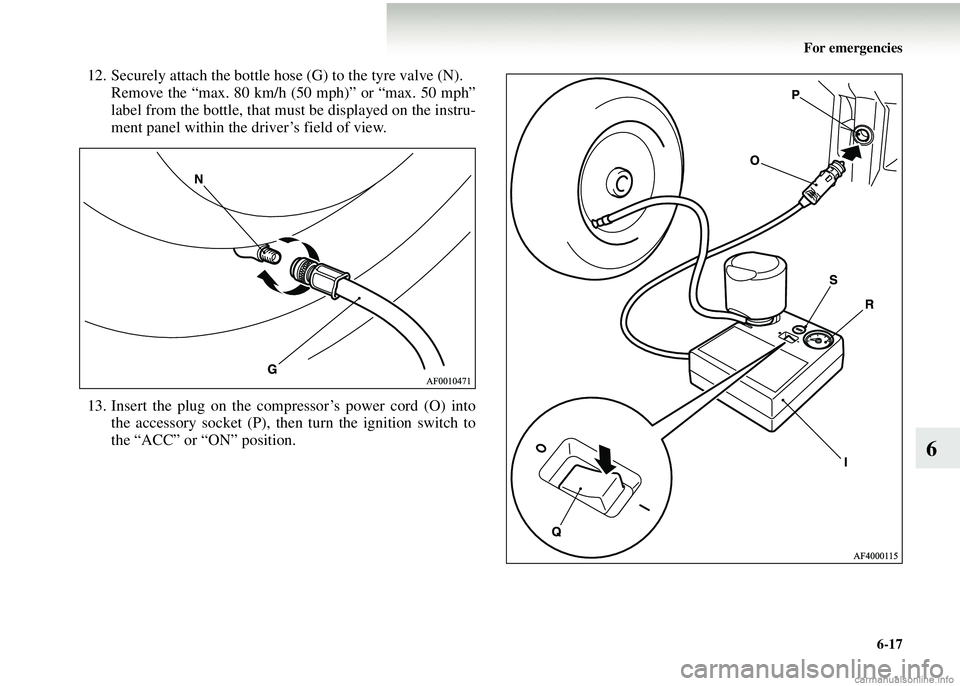
For emergencies6-17
6
12. Securely attach the bottle hose (G) to the tyre valve (N).Remove the “max. 80 km/h (50 mph)” or “max. 50 mph”
label from the bottle, that must be displayed on the instru-
ment panel within the driver’s field of view.
13. Insert the plug on the co mpressor’s power cord (O) into
the accessory socket (P), then turn the ignition switch to
the “ACC” or “ON” position.
Page 308 of 450
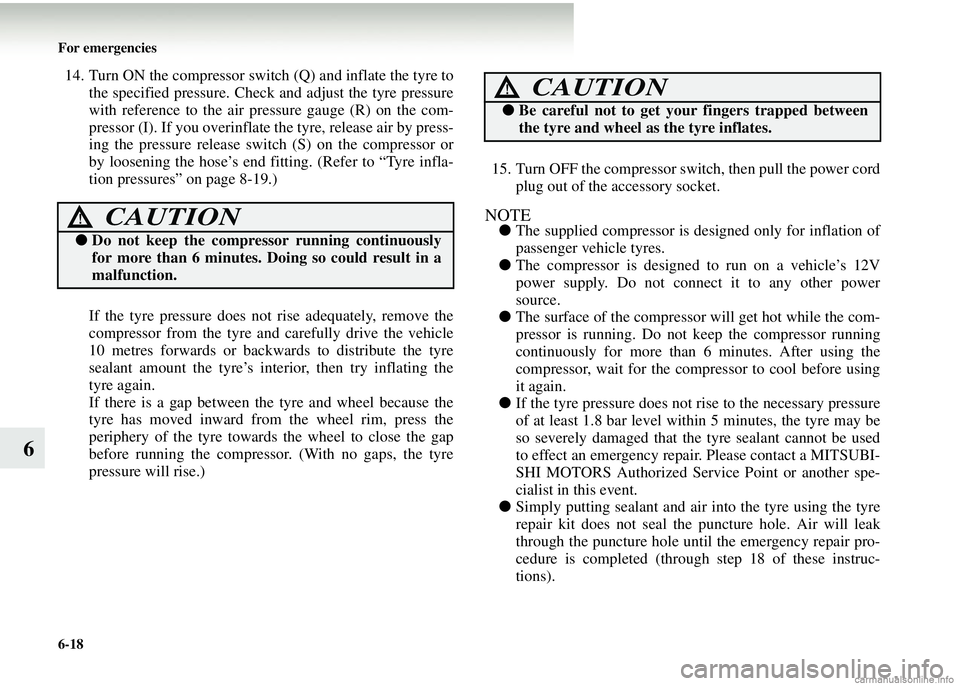
6-18 For emergencies
6
14. Turn ON the compressor switch (Q) and inflate the tyre tothe specified pressure. Check and adjust the tyre pressure
with reference to the air pr essure gauge (R) on the com-
pressor (I). If you overinflate the tyre, release air by press-
ing the pressure release swit ch (S) on the compressor or
by loosening the hose’s end fitting. (Refer to “Tyre infla-
tion pressures” on page 8-19.)
If the tyre pressure does not rise adequately, remove the
compressor from the tyre an d carefully drive the vehicle
10 metres forwards or backwards to distribute the tyre
sealant amount the tyre’s interior, then try inflating the
tyre again.
If there is a gap between th e tyre and wheel because the
tyre has moved inward from the wheel rim, press the
periphery of the tyre toward s the wheel to close the gap
before running the compressor. (With no gaps, the tyre
pressure will rise.) 15. Turn OFF the compressor sw
itch, then pull the power cord
plug out of the accessory socket.
NOTE● The supplied compressor is designed only for inflation of
passenger vehicle tyres.
● The compressor is designed to run on a vehicle’s 12V
power supply. Do not connect it to any other power
source.
● The surface of the compressor will get hot while the com-
pressor is running. Do not keep the compressor running
continuously for more than 6 minutes. After using the
compressor, wait for the compressor to cool before using
it again.
● If the tyre pressure does not rise to the necessary pressure
of at least 1.8 bar level within 5 minutes, the tyre may be
so severely damaged that the tyre sealant cannot be used
to effect an emergency repair. Please contact a MITSUBI-
SHI MOTORS Authorized Service Point or another spe-
cialist in this event.
● Simply putting sealant and air into the tyre using the tyre
repair kit does not seal the puncture hole. Air will leak
through the puncture hole un til the emergency repair pro-
cedure is completed (through step 18 of these instruc-
tions).CAUTION!
● Do not keep the compressor running continuously
for more than 6 minutes. Doing so could result in a
malfunction.
CAUTION!
●Be careful not to get your fingers trapped between
the tyre and wheel as the tyre inflates.
Page 309 of 450
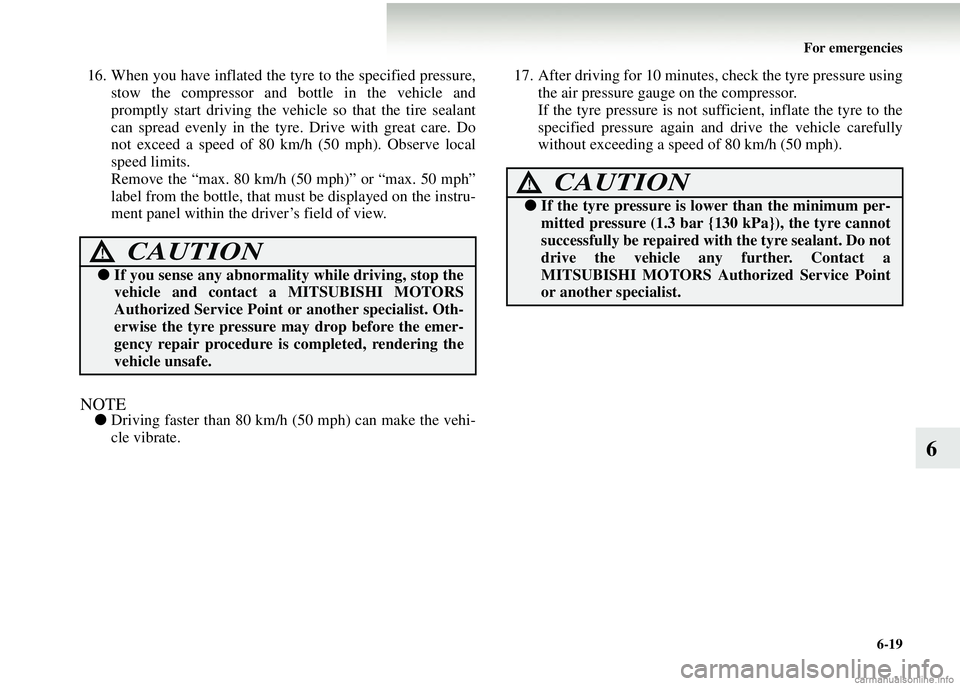
For emergencies6-19
6
16. When you have inflated the ty re to the specified pressure,
stow the compressor and bottle in the vehicle and
promptly start driving the vehi cle so that the tire sealant
can spread evenly in the ty re. Drive with great care. Do
not exceed a speed of 80 km /h (50 mph). Observe local
speed limits.
Remove the “max. 80 km/h (50 mph)” or “max. 50 mph”
label from the bottle, that must be displayed on the instru-
ment panel within the driver’s field of view.
NOTE● Driving faster than 80 km/h (50 mph) can make the vehi-
cle vibrate. 17. After driving for 10 minutes,
check the tyre pressure using
the air pressure gauge on the compressor.
If the tyre pressure is not sufficient, inflate the tyre to the
specified pressure again an d drive the vehicle carefully
without exceeding a speed of 80 km/h (50 mph).
CAUTION!
●If you sense any abnormalit y while driving, stop the
vehicle and contact a MITSUBISHI MOTORS
Authorized Service Point or another specialist. Oth-
erwise the tyre pressure may drop before the emer-
gency repair procedure is completed, rendering the
vehicle unsafe.
CAUTION!
● If the tyre pressure is lower than the minimum per-
mitted pressure (1.3 bar {130 kPa}), the tyre cannot
successfully be repaired with the tyre sealant. Do not
drive the vehicle any further. Contact a
MITSUBISHI MOTORS Auth orized Service Point
or another specialist.
Page 310 of 450
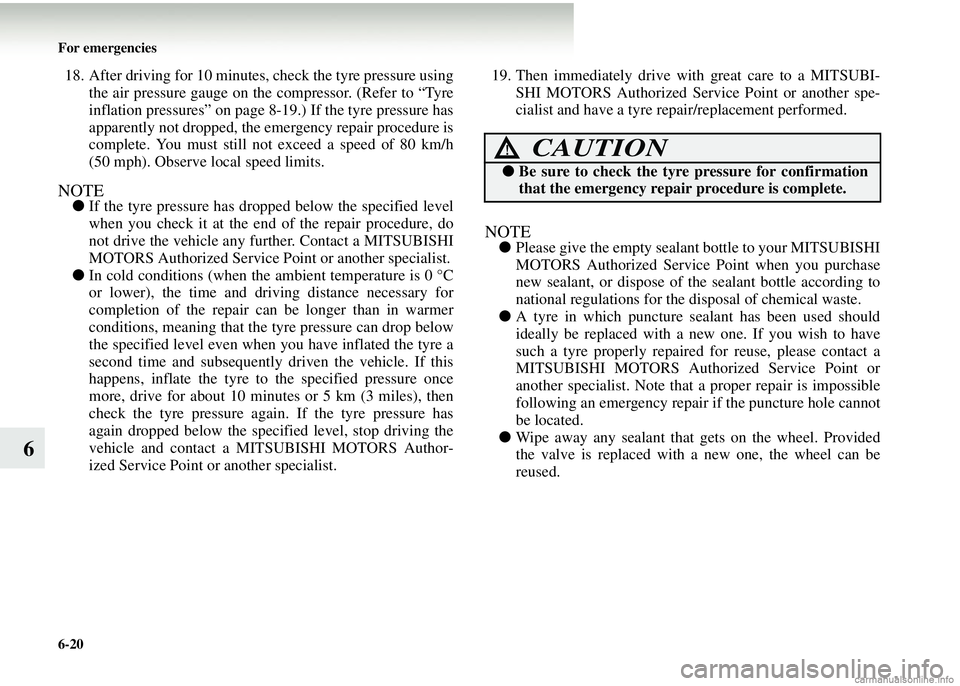
6-20 For emergencies
6
18. After driving for 10 minutes, check the tyre pressure usingthe air pressure gauge on the compressor. (Refer to “Tyre
inflation pressures” on page 8-19.) If the tyre pressure has
apparently not dropped, the emergency repair procedure is
complete. You must still not exceed a speed of 80 km/h
(50 mph). Observe local speed limits.
NOTE●If the tyre pressure has dropped below the specified level
when you check it at the end of the repair procedure, do
not drive the vehicle any fu rther. Contact a MITSUBISHI
MOTORS Authorized Service Point or another specialist.
● In cold conditions (when th e ambient temperature is 0 °C
or lower), the time and driving distance necessary for
completion of the repair can be longer than in warmer
conditions, meaning that the tyre pressure can drop below
the specified level even when you have inflated the tyre a
second time and subsequently driven the vehicle. If this
happens, inflate the tyre to the specified pressure once
more, drive for about 10 minutes or 5 km (3 miles), then
check the tyre pressure again. If the tyre pressure has
again dropped below the specified level, stop driving the
vehicle and contact a MITS UBISHI MOTORS Author-
ized Service Point or another specialist. 19. Then immediately drive wi
th great care to a MITSUBI-
SHI MOTORS Authorized Service Point or another spe-
cialist and have a tyre repair/replacement performed.
NOTE● Please give the empty sealant bottle to your MITSUBISHI
MOTORS Authorized Service Point when you purchase
new sealant, or dispose of the sealant bottle according to
national regulations for the disposal of chemical waste.
● A tyre in which puncture sealant has been used should
ideally be replaced with a new one. If you wish to have
such a tyre properly repaired for reuse, please contact a
MITSUBISHI MOTORS Authorized Service Point or
another specialist. Note that a proper repair is impossible
following an emergency repair if the puncture hole cannot
be located.
● Wipe away any sealant that gets on the wheel. Provided
the valve is replaced with a new one, the wheel can be
reused.
CAUTION!
●Be sure to check the tyre pressure for confirmation
that the emergency repair procedure is complete.